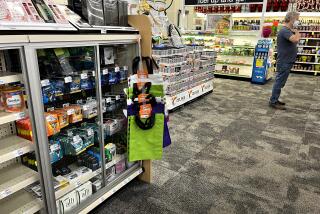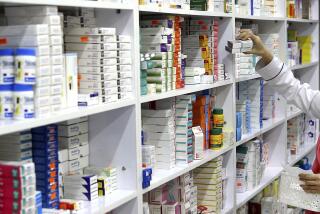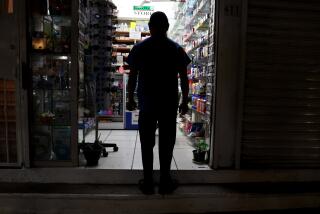Counterfeit Drug Strategy Proposed
- Share via
WASHINGTON — The Bush administration called on the pharmaceutical industry Wednesday to voluntarily adopt measures -- such as tiny electronic tracking devices attached to labels or boxes -- that would stem the growing threat of counterfeit prescription medications in the United States.
“We will take the necessary steps to protect all Americans from those who would exploit and harm them by selling counterfeit drugs,” said Tommy G. Thompson, secretary of the Department of Health and Human Services.
Mark B. McClellan, commissioner of the Food and Drug Administration, said “the vast majority of drugs legally obtained in the United States are legitimate -- well over 99%.” However, the government’s investigations of counterfeit drug operations have increased from less than 10 in 2000 to more than 20 a year.
Last year, for example, the government issued an alert after more than 200,000 bottles of counterfeit Lipitor, a cholesterol drug, had made their way onto the market. In 2001, a Sunnyvale, Calif., pharmacist discovered that bottles of Neupogen, a growth hormone prescribed for AIDS and cancer patients, were filled only with saltwater.
The FDA report on measures to combat drug counterfeiting was compiled in consultation with drug manufacturers, wholesalers, retailers and pharmacy groups. It calls on the drug industry to implement electronic “track-and-trace” technologies by 2007, encourages state governments to adopt stronger anticounterfeiting laws and seeks stiffer criminal penalties for those convicted of making or peddling counterfeit medications.
The government also said it would work to educate consumers and healthcare professionals about what Thompson termed “this increasingly sophisticated public health threat.”
The basic message is “buy your medication from a reputable source,” McClellan said.
The administration’s release of the FDA report was the latest in a series of high-profile actions designed to convince Americans that prescription drugs purchased in unconventional ways -- particularly those bought over the Internet or from Canada -- may not be safe. However, the administration’s warnings do not appear to have dampened the public’s demand for the less expensive Canadian drugs.
Democrats in Congress, joined by some Republicans, have renewed efforts to legalize such purchases, and many of the nation’s governors plan to hold a “summit on prescription drug re-importation” here on Tuesday. Earlier this week, Los Angeles City Councilman Dennis P. Zine said the city could save millions of dollars if it purchased medications for municipal employees from Canada.
Millions of older Americans order drugs over the Internet or from Canada, where government-imposed price controls can make them 50% cheaper than the same medications sold in the United States. For years, the U.S. government has largely ignored those illegal purchases. But the Bush administration sharpened its rhetoric after several cities and states, including California, considered proposals to buy drugs from Canada and two cities -- Springfield, Mass., and Montgomery, Ala. -- began doing so.
The FDA has threatened to take legal action against city or state governments that implement drug-importation programs, and it has joined with pharmacists’ associations in Illinois and California in public-information campaigns designed to discourage consumers from buying medications from Canada.
McClellan said Wednesday that the anticounterfeiting measures proposed in his agency’s report were designed “only for the U.S. legal drug supply.”
“When you go outside of that system, it really is, unfortunately, a ‘buyer beware’ situation. And this report does not provide the solution to that problem,” he said.
Thompson acknowledged the political pressure to legalize drug imports, noting that the new Medicare law requires his department to complete a study of the issue by next year.
But for now, McClellan said, the FDA has “neither the legal authorities to provide effective oversight nor the resources” to ensure that drugs imported into the country are safe.
Administration officials expressed more confidence in their ability to control drug counterfeiting. Most promising, they said, is the development of so-called track-and-trace technologies. Putting tiny computer chips, about a third the size of a grain of rice, behind the labels of pill bottles would allow retailers and pharmacists to ensure the legality of a medication and track its movement from manufacturer to patient, they said.
The implementation of this “electronic pedigree” should cost about a dollar per prescription, officials said, predicting widespread use of the technology by 2007.
Current law requires the drug industry to use a paper-based tracking system, but with distributors and retailers balking at the cost and the logistics, it has never been enforced. The FDA’s new report -- endorsed by the Pharmaceutical Research and Manufacturers of America, the American Medical Assn., the National Assn. of Boards of Pharmacy and other industry groups -- indicated that the agency intends to further delay implementation of the paper-pedigree requirement until December 2006.
By then, the government expects most industry groups to be using the voluntary electronic tracking technology.
“The FDA is not going to require this by regulation,” said William Hubbard, the FDA’s senior associate commissioner.
More to Read
Sign up for Essential California
The most important California stories and recommendations in your inbox every morning.
You may occasionally receive promotional content from the Los Angeles Times.













